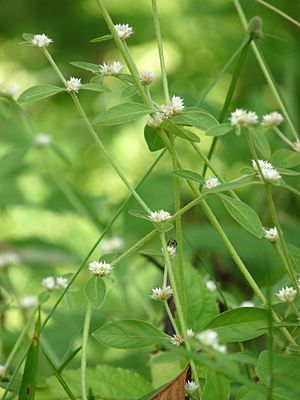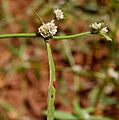Alternanthera sessilis facts for kids
Quick facts for kids Alternanthera sessilis |
|
|---|---|
 |
|
| Conservation status | |
| Scientific classification | |
| Genus: |
Alternanthera
|
| Species: |
sessilis
|
| Synonyms | |
|
|
Alternanthera sessilis is a common flowering plant. It has many names like sissoo spinach, Brazilian spinach, sessile joyweed, and dwarf copperleaf. People around the world grow it as a vegetable.
Contents
Where Does Alternanthera Sessilis Grow?
This plant grows naturally in warm, tropical, and subtropical parts of the world. These areas include places in Asia, Africa, and Australia. It has also been brought to the southern United States. We are not sure if it originally came from Central America or South America.
In some parts of the southern USA, this plant is seen as a weed. This means it grows where it is not wanted. It often grows in wet or damp places. In very humid areas, it can even become a garden weed.
What Does Alternanthera Sessilis Look Like?
Alternanthera sessilis is a plant that lives for many years. Its stems usually spread out along the ground. They can sometimes grow upwards. The stems often grow roots from their joints, called nodes.
The leaves are shaped like an oval or a wide ellipse. They can be 1 to 15 centimeters long and 0.3 to 3 centimeters wide. The leaves can be smooth or have a few hairs. Their small stems, called petioles, are 1 to 5 millimeters long.
The flowers grow in tight clusters without stalks. These clusters are called sessile spikes. The small leaves around the flowers are shiny white. They are 0.7 to 1.5 millimeters long. The sepals, which protect the flower, are 2.5 to 3 millimeters long. This plant usually flowers from December to March in the wild.
How Do People Use Alternanthera Sessilis?
People use Alternanthera sessilis in many ways. It grows wild, but it is also grown on farms. It is used for food, as a traditional medicine, and sometimes as a pretty plant. Another plant, Alternanthera reineckii, which is used in aquariums, is sometimes mistaken for A. sessilis.
Alternanthera Sessilis as Food
In some parts of Southeast Asia, people eat the leaves and young shoots. In India, especially in Karnataka, Andhra Pradesh, and Tamil Nadu, the leaves, flowers, and soft stems are eaten as vegetables. They are often chopped finely and stir-fried with grated coconut and spices. This dish is called "mukunuwenna mellum."
The leaves are crunchy, even more so than regular spinach. They are not slimy. Some types of the plant can taste a bit bitter. If you eat a lot of them, you should steam or boil them. This is because they contain natural substances called oxalates. You can eat it alone as a green vegetable or add it to other dishes.
Some people in Brazil eat it raw in salads with oil, vinegar, tomato, and onion. However, many experts suggest cooking it. This vegetable can be added to dishes like quiches, pies, curries, and dals. You can also add it to pasta sauces, lasagna, or stir-fries near the end of cooking. It can replace spinach and add a nutty flavor to your meal.
Alternanthera Sessilis in Medicine
In traditional medicine, this plant has several helpful properties. It can help the body remove extra water (diuretic). It can also be cooling, strengthening (tonic), and help with digestion (laxative). It has been used to treat painful urination and haemorrhoids. People also believe the plant is good for the eyes. It is sometimes used in special hair oils and a traditional eye makeup called kajal.
What is Sissoo Spinach?
Sissoo spinach is a special type of Alternanthera sessilis. It was developed in Brazil. It is known as a "non-conventional food plant" in South America. Sometimes, it is called Alternanthera sissoo scientifically, but this name is not officially accepted.
Sissoo spinach is a strong plant that spreads easily. It grows about 30 centimeters (12 inches) high and has crinkly leaves. It grows roots from its nodes, which are joints on the stem. This type of plant does not produce seeds that can grow new plants. Because of this, it is not considered an invasive species.
This plant likes at least 50% shade. It can grow in many different soil types, but it needs a lot of nitrogen, organic matter, and water. Caterpillars and slugs can sometimes eat its leaves. Sissoo spinach can be planted under fruit trees to help the soil. New plants are grown from cuttings, which are small pieces of the plant.
Gallery
See also
 In Spanish: Alternanthera sessilis para niños
In Spanish: Alternanthera sessilis para niños





